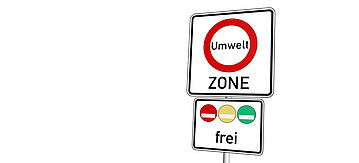Emissions-control sticker / Low emission zone

Many German cities have introduced low emission zones to mitigate air pollution caused by fine particles and nitrogen dioxide. Traffic signs and additional signs mark the entry to low emission zones. The Thirty-fifth Ordinance on the Implementation of the Federal Immission Control Act (Ordinance on the marking of vehicles) stipulates that vehicles have to be marked with stickers (on the windscreen inside the vehicle) and lays down the criteria vehicles have to meet for the different kinds of stickers. Stickers are valid for all low emission zones in Germany.
An overview of low emission zones in Germany is available at the German Environment Agency's website.
Furthermore, cities provide important information about their low emission zones on their websites (size, exceptions, service, practical advice).
Emissions groups — Red, yellow and green emissions-control stickers
Vehicles are divided into emissions groups according to their particulate emissions and they receive a sticker of the colour marking the respective emissions group:
- red for emissions group 2,
- yellow for emissions group 3 and
- green for emissions group 4.
Only vehicles displaying the required stickers may enter low emission zones. Stickers are only mandatory for those wishing to drive their cars into these zones. They are not required when crossing the border into Germany.
Section 6 of the Ordinance on the marking of vehicles clearly lays down which vehicles belong to which emissions group. If registration papers do not identify the European emission standard of a vehicle, the date of the vehicle's first registration is used as a basis for classification. As a rule, retrofitting with an emissions control device such as a particulate trap will take a diesel-powered vehicle up one emissions group. The higher standard achieved (as regulated by the Ordinance on the marking of vehicles) must be certified by the garage which performed the retrofit. Vehicles with a drive other than a combustion system (for example electric vehicles) fall under emissions group 4 and receive a green sticker.
Where to obtain emissions-control stickers
Stickers can be obtained from the local licensing authorities or other competent bodies designated under Länder law. Another option are bodies authorised to carry out exhaust gas examinations (garages, service stations with garages, and inspection agencies in Germany such as Dekra and TÜV [Technical Inspection Authority], or their offices abroad).
Stickers will be issued by any of these bodies upon presentation of vehicle registration papers.
It is also possible to order stickers from one of the above-mentioned bodies before driving into a low emission zone. You may submit your registration papers (in principle, copies do not need to be officially certified) via fax or email (scanned document) or as copy by post. The sticker will be sent to you by post. The issuing bodies charge between five and ten euros for one sticker. Costs for shipped stickers, including postage, may be higher.
Exemptions from the obligation to display a sticker may be granted in accordance with Section 1 (2) and Annex 3 to Section 2 (2) of the Ordinance on the marking of vehicles. It is not permitted to enter a low emission zone without a sticker or special authorisation (fine: 80 euros).
Overview of emissions groups for vehicles
(Derogations may apply)
| European emission standard | Emissions group | First registration passenger car | First registration lorries / busses | Sticker |
|---|---|---|---|---|
| Diesel engines | Diesel engines | |||
| Euro 1 or less | 1 | before 1 January 1997 | before 1 October 1996 | none |
| Euro 2 or Euro 1 with retrofit | 2 | from 1 January 1997 to 31 December 2000 | from 1 October 1996 to 30 September 2001 | red |
| Euro 3 or Euro 2 with retrofit | 3 | from 1 January 2001 to 31 December 2005 | from 1 October 2001 to 30 September 2006 | yellow |
| Euro 4 and higher or Euro 3 with retrofit | 4 | from 1 January 2006 | from 1 October 2006 | green |
| petrol engines | petrol engines | |||
| Euro 1 or less (vehicles which do not meet group 4 criteria) | 1 | before 1 January 1993 | before 1 January 1993 | none |
| Euro 1 and higher or Annex XXIII to Road Traffic Registration Regulations (StVZO) or equivalent or 52nd Ordinance on derogations to the StVZO or equivalent | 4 | from 1 January 1993 | from 1 January 1993 | green |
The mean annual threshold for nitrogen dioxide, laid down with the aim of protecting human health, has been exceeded in many cities for a long time, in some cases significantly, due to the excessive amount of nitrogen oxide emissions generated by diesel vehicles under real-world driving conditions. Therefore, in addition to the regulations on low emission zones, Berlin, Darmstadt and Hamburg have imposed bans on diesel passenger cars up to and including emission standard Euro 5 for certain routes. Stuttgart is furthermore implementing a zonal ban on Euro 4/IV diesel motor vehicles and in a small low-emission zone, plans to ban all diesel motor vehicles with emission standard Euro 5/V or less. No new stickers were introduced to monitor compliance with these bans. Where additional traffic bans are necessary in order to reduce nitrogen dioxide emissions in the short term, they can be monitored by the competent local authorities through randomised mobile number plate recognition, in accordance with the amended Federal Road Traffic Act (entry into force in 2019). In light of the fact that nitrogen dioxide emissions dropped significantly in 2019 and 2020, it can be assumed that additional bans on Euro 4/IV and Euro 5/V diesel vehicles beyond the regulations on low emission zones no longer need to be imposed.
